When it comes to growing cabbage, did you know that companion planting can make a significant impact on its health and overall productivity? By strategically selecting companion plants, you can create a harmonious garden ecosystem that improves disease control, pest deterrence, soil health, and yield for your cabbage crops. The benefits extend beyond the cabbage itself, attracting beneficial insects and promoting biodiversity in your garden.
If you’re interested in organic gardening and want to optimize the growth and health of your cabbage crops, look no further! In this guide, I’ll share my top companion plants for cabbage, explaining how they can help you cultivate healthier and more abundant cabbage. From pest control to soil improvement, these companion plants are here to lend a helping hand.
Key Takeaways:
- Companion planting can enhance the health and productivity of cabbage crops by improving disease control and pest deterrence.
- Selecting the right companion plants can attract beneficial insects and promote biodiversity in your garden.
- Some recommended cabbage companion plants include agastache, alliums, borage, beans and peas, clover, dill, leafy greens, marigolds, and mint.
- These companion plants offer various benefits such as pest control, soil health improvement, moisture retention, and flavor enhancement.
- By incorporating companion plants into your cabbage patch, you can enjoy healthier crops and a more successful gardening experience overall.
Understanding Cabbage and Companion Planting
Cabbage, a member of the cole crop family, is a versatile cool-season vegetable that comes in various colors and sizes. Commonly found in green, red, and white varieties, cabbage is a popular addition to many culinary dishes. However, cabbage is not without its challenges. Pests and diseases can pose a threat to its growth and overall health, making companion planting an essential practice for successful cabbage cultivation.
Companion planting involves growing compatible plants together to create a mutually beneficial environment. When it comes to cabbage, companion plants play a crucial role in protecting the crop from pests, improving soil health, and promoting overall vigor. A well-planned companion planting strategy can help optimize cabbage growth and yield while creating a diverse and balanced garden ecosystem.
It’s important to note that cabbage has allelopathic properties. This means it releases chemical compounds that can inhibit the growth of neighboring plants. When selecting companion plants for cabbage, it’s crucial to choose species that can tolerate this allelopathic behavior. These companion plants should not only coexist harmoniously with cabbage but also offer valuable interactions that contribute to the cabbage’s well-being.
By understanding the unique characteristics of cabbage and the principles of companion planting, we can effectively harness the benefits of companion plants to enhance the health and productivity of our cabbage crops.
Key Points:
- Cabbage belongs to the cole crop family and is a cool-season vegetable.
- Companion plants protect cabbage from pests and diseases.
- Cabbage has allelopathic qualities, inhibiting the growth of nearby plants.
- Companion plants for cabbage should tolerate cabbage’s allelopathic behavior.
- Companion planting creates a balanced and diverse garden ecosystem.
Agastache as a Cabbage Companion Plant
When it comes to finding the perfect companion plant for cabbage, look no further than Agastache, also known as anise hyssop. This aromatic herb not only adds beauty to your garden but also offers valuable benefits to your cabbage crops.
Agastache is a natural magnet for beneficial pollinators like bees, attracting them with its vibrant flowers and enticing fragrance. This can significantly increase pollination rates for your cabbage plants, resulting in better yields and larger, more flavorful heads.
But that’s not all. Agastache also acts as a reliable guardian against cabbage moths, a common cabbage pest known for its destructive caterpillars. The strong scent of Agastache repels these pesky insects, keeping your cabbage plants protected and healthy.
The use of Agastache as a companion plant brings not only practical benefits but also promotes biodiversity in your garden. By attracting pollinators and repelling pests, Agastache creates a balanced ecosystem that supports the overall health and vitality of your cabbage patch.
| Benefits of Agastache as a Cabbage Companion Plant |
|---|
| Attracts beneficial pollinators like bees |
| Deters cabbage moths and their caterpillars |
| Promotes biodiversity in the garden |
| Enhances cabbage yields and head size |
If you’re interested in incorporating Agastache into your cabbage companion planting strategy, consider planting it in close proximity to your cabbage crops. The vibrant flowers and fragrant leaves will not only add visual appeal to your garden but also provide a valuable line of defense against pests and enhance the overall success of your cabbage growing endeavors.
Alliums for Pest Control
When it comes to protecting your cabbage crops from pests, alliums are a valuable ally. Alliums include onions, garlic, and chives, and their pungent smell acts as a natural deterrent for pests that commonly attack cabbage, such as aphids, slugs, and deer. By planting alliums alongside your cabbage, you can create a barrier that masks the scent of the cabbage, making it less attractive to these unwanted visitors.
Alliums are not only effective at pest deterrence, but they also offer additional benefits to your garden. Their strong aroma helps to repel other insects and animals, providing a defense against a range of pests. Additionally, alliums are known for their ability to improve soil health by deterring certain soil-borne pests and promoting beneficial microorganisms.
To make the most of alliums as cabbage companion plants, consider interplanting them throughout your cabbage patch. Alternatively, you can create a border around your cabbage bed using alliums to form a natural barrier against pests. This strategic placement will maximize the benefits of alliums, safeguarding your cabbage crops and promoting a healthier garden ecosystem.
So, don’t just stop at using alliums in your kitchen recipes—let them also serve as powerful allies in your cabbage garden.
Benefits of Alliums as Cabbage Companion Plants:
- Repels pests like aphids, slugs, and deer
- Mask the scent of cabbage, making it less attractive to pests
- Promotes a healthier garden ecosystem
- Improves soil health by deterring certain pests and enhancing beneficial microorganisms
By harnessing the power of alliums as cabbage companion plants, you can effectively protect your crops and cultivate a thriving garden.
Borage for Pest Deterrence and Pollination
When it comes to companion planting for cabbage, borage is a superstar. Not only does this herb deter cabbage moth caterpillars, but it also attracts essential pollinators to your garden. The vibrant blue flowers of borage act as a tasty food source for bees and other beneficial insects, boosting the productivity of your cabbage plants. Plus, borage leaves and flowers are not just visually appealing; they’re also edible, adding a unique flavor and versatility to your culinary creations.
If you’re looking to create a thriving cabbage patch that’s naturally protected from pests and enriched by pollinators, borage is an ideal choice. Let’s explore the remarkable benefits of this cabbage companion plant in more detail.
Pest Deterrence
Borage is highly effective at deterring cabbage moth caterpillars, a common pest that can wreak havoc on cabbage crops. By planting borage near your cabbages, you can create a natural barrier that helps keep these destructive caterpillars at bay. This means healthier cabbages and less damage to your beloved crops.
Pollination Heaven
One of the key benefits of borage as a cabbage companion plant is its ability to attract a variety of pollinators. Bees, butterflies, and other beneficial insects are drawn to the vibrant blue flowers of borage, making it an irresistible pollination hotspot in your garden. These pollinators play a crucial role in fertilizing cabbage flowers, leading to more abundant harvests and healthier plants.
| Borage as a Companion Plant for Cabbage | |
|---|---|
| Pest Control | Deterring cabbage moth caterpillars |
| Pollination | Attracting bees and other beneficial pollinators |
| Edibility | Leaves and flowers can be used in culinary creations |
As you can see, borage offers multiple benefits to cabbage plants, making it an invaluable companion in your garden. By incorporating this herb into your planting scheme, you can create a thriving and balanced ecosystem that supports the growth and productivity of your cabbage crops.
Next, let’s explore another fantastic cabbage companion plant: beans and peas. These legumes not only help optimize space in your garden but also contribute to soil health. Stay tuned!
Beans and Peas for Soil Health and Space Optimization
When it comes to companion planting for cabbage, beans and peas are a winning combination. Both of these cool-season crops not only thrive alongside cabbage but also offer significant benefits to soil health and space optimization in your garden.
One of the key advantages of interplanting cabbage with beans and peas is their ability to fix nitrogen in the soil. These leguminous plants have a symbiotic relationship with nitrogen-fixing bacteria, which allows them to convert atmospheric nitrogen into a usable form for themselves and neighboring plants. This process enhances soil fertility and provides an essential nutrient for cabbage growth and overall yield.
By including beans and peas as cabbage companion plants, you can optimize limited garden space. These plants have similar growing conditions and can be interplanted in a compact manner without competing for resources. This efficient use of space not only allows you to maximize your cabbage crop but also adds visual appeal to your garden with the contrasting foliage and colors.
So, if you’re looking to boost soil health, maximize garden space, and create a visually stunning cabbage patch, consider incorporating beans and peas as companion plants for your cabbage. Their nitrogen-fixing capabilities and harmonious growth habits make them valuable additions to your gardening repertoire.
Clover for Pest Control and Soil Health
When it comes to companion plants for cabbage, one particularly beneficial option is clover. Not only does clover help deter cabbage worms, but it also acts as a living mulch to retain soil moisture and control weeds. By planting clover around your cabbage, you can enhance pest control and contribute to the overall health of your garden.
Clover plays a dual role in supporting your cabbage plants. Firstly, it acts as a natural deterrent for cabbage worms, which can cause significant damage to cabbage leaves if left unchecked. The presence of clover creates an environment that cabbage worms find less appealing, helping to protect your cabbage crops without the need for chemical pesticides.
Additionally, clover provides several benefits for the soil. As a living mulch, it helps retain moisture, preventing excessive evaporation and ensuring that your cabbage plants have access to water during dry periods. This can be particularly beneficial for cabbage, as they require consistent moisture to thrive.
“The presence of clover creates an environment that cabbage worms find less appealing, helping to protect your cabbage crops without the need for chemical pesticides.”
Furthermore, clover is a nitrogen-fixing plant, meaning that it has the ability to capture atmospheric nitrogen and convert it into a form that is easily absorbed by plants. This helps improve soil fertility and provides cabbage with the necessary nutrients for healthy growth. By planting clover alongside your cabbage, you can naturally enrich the soil and create a more conducive environment for your cabbage plants.
Overall, clover is a versatile and valuable companion plant for cabbage. Its ability to deter pests, retain soil moisture, and improve soil health makes it an excellent choice for any cabbage gardener. Consider adding clover to your garden to experience the benefits it brings to your cabbage crops.
| Clover Benefits for Cabbage | |
|---|---|
| Deters cabbage worms | 🌿 |
| Acts as a living mulch for moisture retention | 🌧️ |
| Controls weeds | 🌱 |
| Improves soil health through nitrogen fixation | 🌿 |
Dill for Pest Repellence and Flavor Enhancement
When it comes to companion planting for cabbage, dill is a fantastic option that offers both pest control and flavor-enhancing benefits. The strong scent of dill acts as a natural deterrent, keeping cabbage moths and cabbage worms at bay, thus protecting your precious cabbage crops. This means you can enjoy healthier, pest-free cabbage plants without the need for harmful chemicals.
But the advantages of dill don’t stop there. When dill is allowed to flower, it becomes a magnet for beneficial insects and pollinators such as bees. These helpful creatures play a crucial role in maintaining a vibrant and balanced garden ecosystem. By attracting them to your garden with dill, you promote biodiversity and create an environment that supports healthy plant growth.
Not only is dill beneficial in the garden, but it also adds a burst of fresh flavor to your culinary adventures. The aromatic flowers of dill can be harvested and used to enhance the taste of various dishes, from salads to sauces and beyond. So with dill, you’re not only protecting your cabbage plants but also adding versatility and deliciousness to your kitchen.
“I love planting dill next to my cabbage because it not only keeps the pests away but also attracts beautiful butterflies and bees to my garden. Plus, the delicious taste of fresh dill in my dishes is simply unbeatable!” – Garden enthusiast
Here’s a quick summary of the benefits of planting dill as a cabbage companion:
- Repels cabbage moths and cabbage worms, acting as a natural pest control.
- Attracts beneficial insects and pollinators, fostering a healthy garden ecosystem.
- Provides a fresh and distinctive flavor to your culinary creations.
| Pest Control | Garden Ecosystem | Flavor Enhancement |
|---|---|---|
| Repels cabbage moths and worms | Attracts beneficial insects and pollinators | Adds a burst of fresh flavor to dishes |
With dill as a cabbage companion plant, you can enjoy the benefits of pest control, biodiversity, and enhanced taste. Your garden will thrive, and your cabbage dishes will be even more delightful. So why not give dill a try and experience the magic it brings to your cabbage patch?
Leafy Greens for Moisture Retention and Space Optimization
When it comes to companion planting for cabbage, leafy greens like spinach and arugula are a perfect choice. Not only do they share the same cool-season growing conditions, but they also offer several benefits that can optimize your garden space and enhance the health of your cabbage crops.
One advantage of planting leafy greens alongside cabbage is their ability to retain moisture in the soil. These plants act as a living mulch, protecting the soil from moisture loss due to evaporation and reducing the need for frequent watering. This is especially beneficial for cabbage, as it requires consistent moisture for optimal growth. By interplanting cabbage with leafy greens, you can create a microclimate that promotes moisture retention, ensuring your cabbage plants receive the hydration they need to thrive.
Another advantage of including leafy greens as cabbage companion plants is their space optimization qualities. Both spinach and arugula have compact growth habits, allowing them to be grown in proximity to cabbage without competing for space. This allows you to maximize the use of your garden area, achieving a bountiful harvest from a limited footprint.
Moreover, planting leafy greens alongside cabbage offers the added benefit of multiple harvests. While you wait for your cabbage heads to fully mature, you can continuously harvest the tender leaves of spinach and arugula. This not only provides you with a variety of fresh greens for your meals but also increases the yield from your garden, making the most of your planting efforts.
“Interplanting leafy greens with cabbage optimizes garden space, retains soil moisture, and increases overall yield.”
Marigolds for Pest Control and Soil Protection
Marigolds are an excellent choice as companion plants for cabbage, offering both pest control and soil protection benefits. These vibrant flowers are known for their natural pest-repelling properties, making them a valuable addition to any cabbage patch.
When planted alongside cabbage, marigolds act as a deterrent to common pests such as aphids and whiteflies, helping to minimize potential damage to your cabbage crops. These flowers release a chemical that effectively deters root nematodes as well, providing an additional layer of protection for your cabbage plants.
“Marigolds offer a natural and visually appealing solution for cabbage growers. Their ability to deter pests while enhancing the beauty of the garden is truly remarkable.”
Furthermore, marigolds contribute to soil protection by creating a barrier that helps retain moisture and control erosion. Their dense foliage shades the soil, preventing excessive evaporation and reducing the risk of nutrient leaching. By incorporating marigolds into your cabbage companion planting scheme, you can help maintain the health and fertility of the soil, promoting optimal growth for your cabbage crops.
Enhancing the Visual Appeal of Your Cabbage Patch
Aside from their practical benefits, marigolds also add a pop of color and visual interest to your cabbage patch. With their vibrant hues of orange, yellow, and maroon, these flowers create a visually stunning contrast against the green foliage of cabbage plants.
Integrating marigolds into your garden design not only enhances the aesthetic appeal but also attracts beneficial insects like bees and butterflies, contributing to the overall health and biodiversity of your garden ecosystem.
Next, let’s take a closer look at how mint can repel pests and support soil health as another valuable companion plant for cabbage.
Mint for Pest Repulsion and Soil Health
When it comes to protecting cabbage from pests and improving soil health, mint is an invaluable companion plant. Its strong scent repels cabbage moths, flea beetles, and aphids, keeping your cabbage crops safe from infestations. Additionally, mint has the remarkable ability to attract beneficial insects like predatory wasps and earthworms. These helpful creatures contribute to pest control by preying on pests that can damage cabbage plants. They also enhance soil health through their activities, improving nutrient availability and soil structure.
However, it’s important to exercise caution when cultivating mint as a companion plant. Mint has a tendency to spread aggressively and take over garden spaces. To prevent its invasive nature, it is advisable to keep mint confined to a pot or a controlled area. By doing so, you can enjoy the benefits of mint’s pest-repelling properties and soil-enhancing capabilities without worrying about its overgrowth.
Mint as a Natural Pest Repellent
Mint’s strong scent acts as a natural deterrent for cabbage moths, flea beetles, and aphids, preventing them from infesting your cabbage plants. The aroma masks the scent of cabbage, making it less attractive to these pests. By interplanting mint alongside cabbage, you create an invisible barrier that discourages pests and helps protect your crops naturally.
Mint’s Contribution to Soil Health
One of the many benefits of mint as a companion plant is its positive impact on soil health. Mint belongs to the mint family, which includes plants with a deep-rooting system. These deep roots help improve soil structure by aerating it and breaking up compacted soil. Mint also releases essential oils, which can contribute to the overall health of the soil. These oils attract earthworms, which are considered gardeners’ allies due to their capacity to enhance soil fertility through their feeding and burrowing activities.
Using Mint in the Garden
When incorporating mint into your cabbage companion planting scheme, it’s crucial to consider its growth habits and potential invasiveness. To keep mint under control, it is recommended to plant it in a pot or container. This way, you can prevent it from spreading uncontrollably and taking over other plants in your garden. Position the mint container near your cabbage plants to maximize its pest-repelling effects, but be sure to provide enough space to avoid overcrowding. The aromatic presence of mint will help protect your cabbage from pests and contribute to the overall health of your garden ecosystem.
| Mint as a Cabbage Companion Plant | Pest Repulsion | Soil Health |
|---|---|---|
| Advantages | – Repels cabbage moths, flea beetles, and aphids | – Attracts beneficial insects like predatory wasps and earthworms |
| Considerations | – Can become invasive if not contained | – Plant in a pot or controlled area to prevent overgrowth |
By harnessing the power of mint as a cabbage companion plant, you can enjoy the benefits of natural pest repulsion and improved soil health. Just remember to keep mint growth under control, allowing it to thrive while safeguarding the balance of your garden ecosystem.
Conclusion
Companion planting is a valuable technique for improving the health and productivity of your cabbage crops. By selecting the right companion plants, you can enhance pest control, promote soil health, and create a diverse and balanced garden ecosystem. These cabbage growing tips, along with the recommended companion plants discussed in this guide, can significantly contribute to the success of your gardening experience.
When it comes to companion planting for healthier cabbage, consider incorporating plants like agastache, alliums, borage, beans, peas, clover, dill, leafy greens, marigolds, and mint. These plants offer a range of benefits, from deterring pests to improving soil health, making them ideal companions for your cabbage.
Remember to plan your garden layout strategically, interplanting cabbage with the designated companions in a way that maximizes space utilization and optimizes the plants’ interactions. By implementing these companion planting techniques, you can enjoy healthier and more abundant cabbage crops while fostering a thriving garden ecosystem.

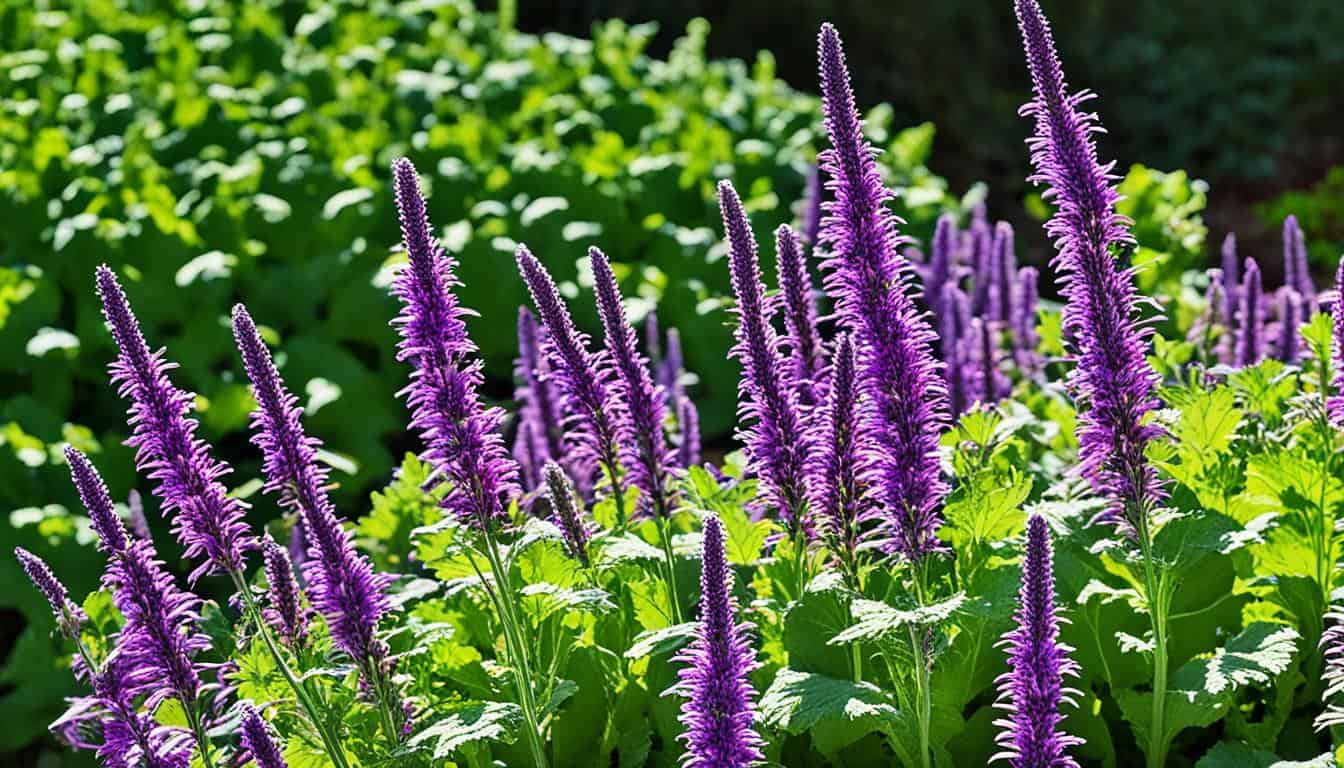
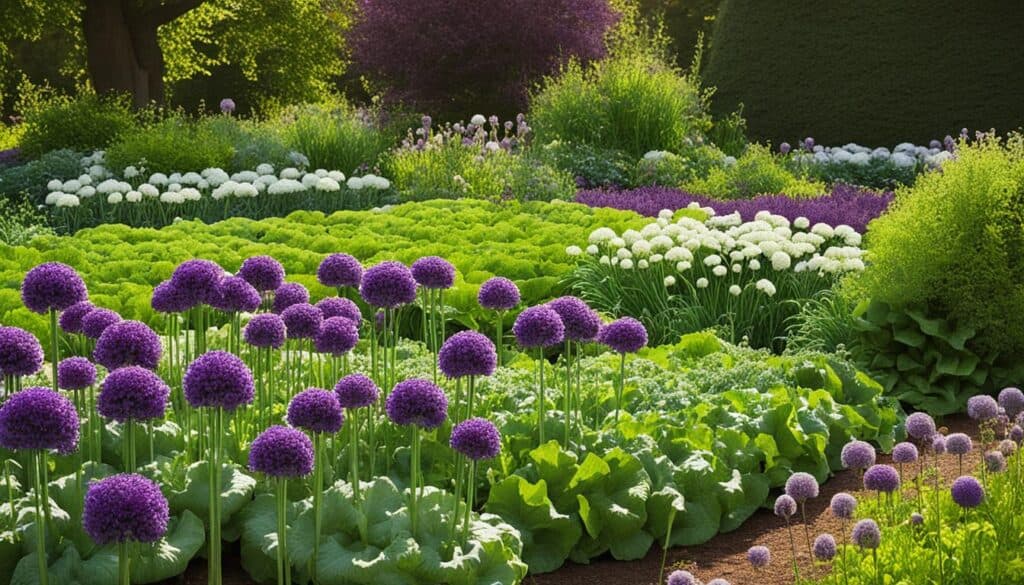
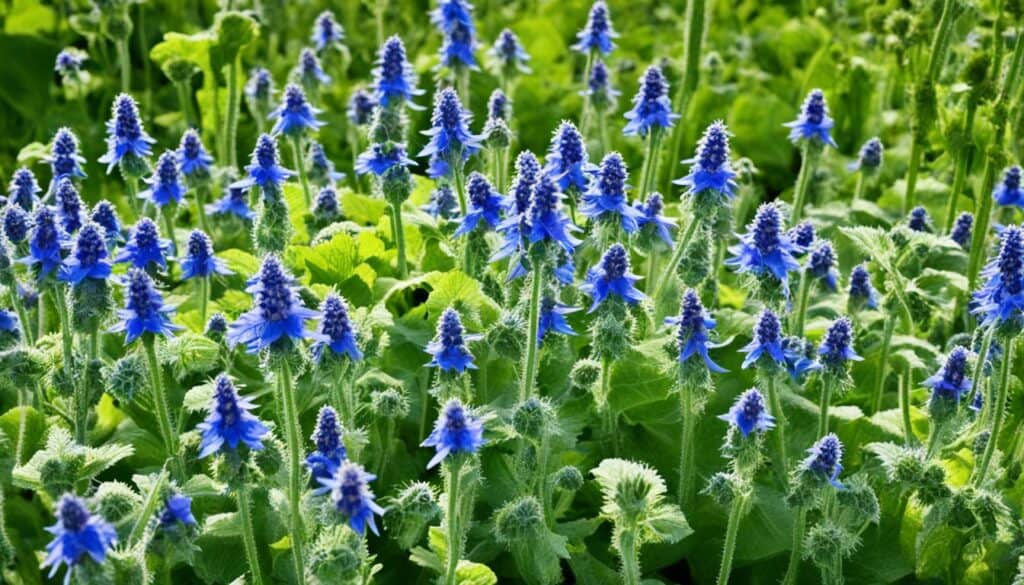
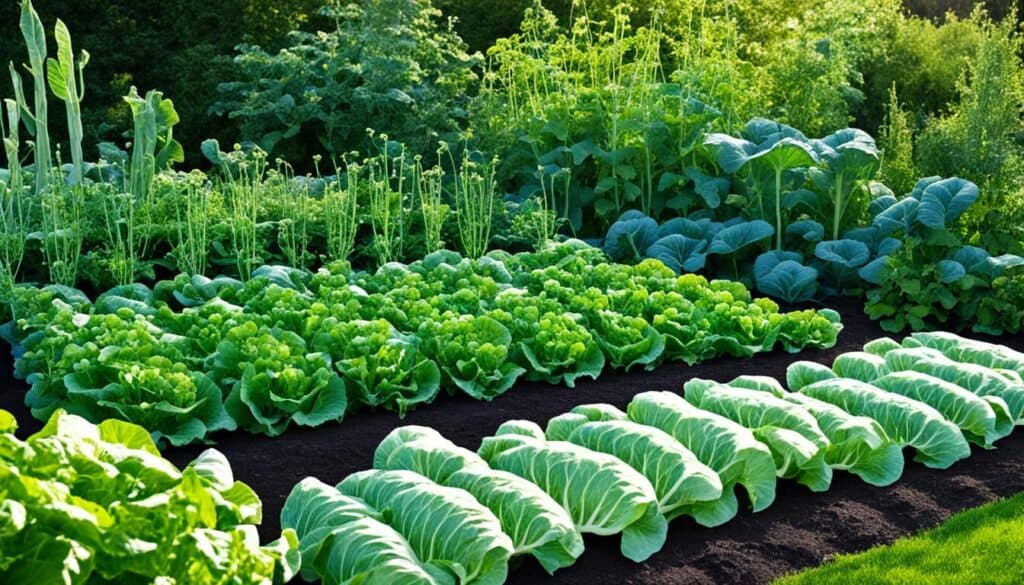
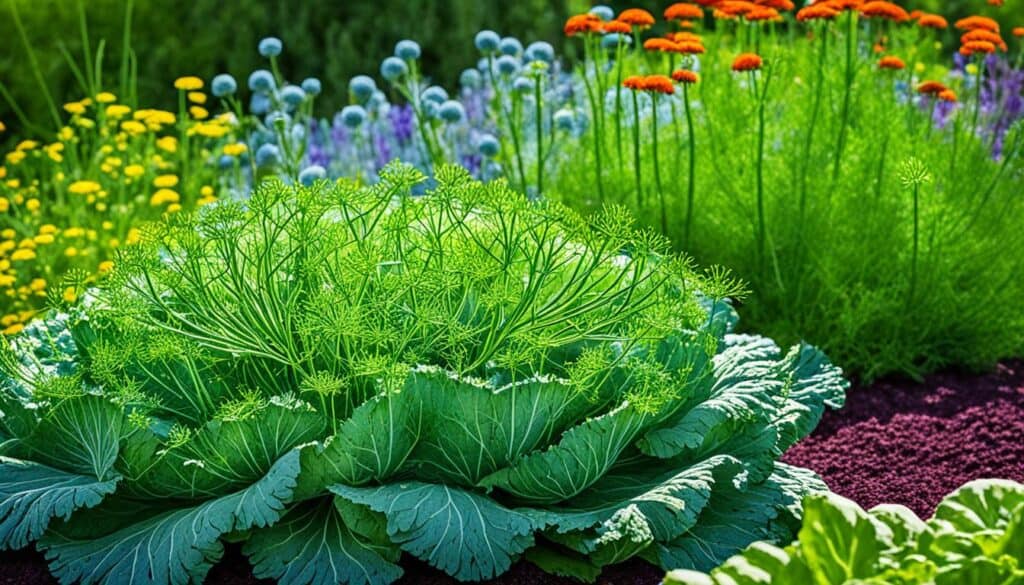
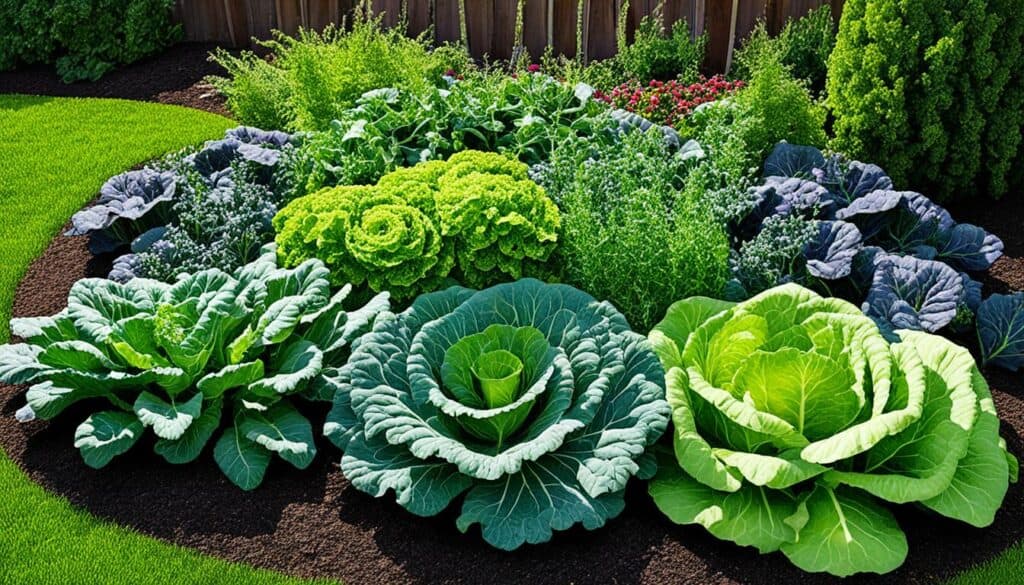



Leave a Reply